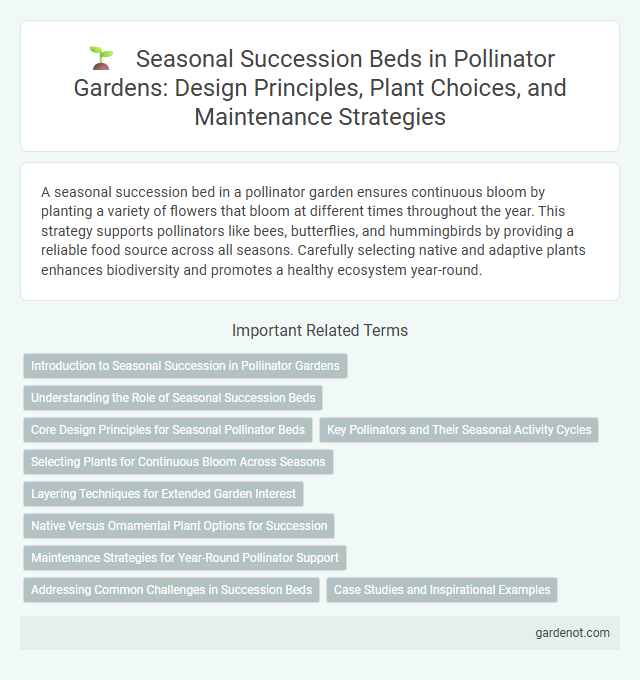A seasonal succession bed in a pollinator garden ensures continuous bloom by planting a variety of flowers that bloom at different times throughout the year. This strategy supports pollinators like bees, butterflies, and hummingbirds by providing a reliable food source across all seasons. Carefully selecting native and adaptive plants enhances biodiversity and promotes a healthy ecosystem year-round.
Introduction to Seasonal Succession in Pollinator Gardens
Seasonal succession in pollinator gardens ensures continuous bloom cycles that support diverse pollinators year-round. Planting a variety of native flowers with staggered flowering times maximizes nectar and pollen availability from early spring through late fall. This practice enhances habitat resilience and promotes sustainable pollinator populations by providing essential resources throughout changing seasons.
Understanding the Role of Seasonal Succession Beds
Seasonal succession beds play a crucial role in maintaining continuous blooms and sustaining pollinator populations throughout the year by carefully selecting and planting a variety of flowering species that bloom at different times. These beds support biodiversity and provide vital nectar and pollen sources during early spring, summer, and fall, ensuring pollinators such as bees, butterflies, and hummingbirds have food available across seasons. Effective planning of seasonal succession beds enhances the resilience of pollinator gardens by creating a dynamic habitat that adapts to changing environmental conditions and pollinator needs.
Core Design Principles for Seasonal Pollinator Beds
Seasonal succession beds prioritize diverse bloom periods to ensure continuous forage for pollinators throughout the growing season, enhancing habitat stability and pollinator diversity. Core design principles include selecting native plant species with overlapping bloom times, incorporating structural diversity to support various pollinator species, and maintaining soil health for sustained plant vigor. Effective layering of early, mid, and late-season flowering plants optimizes nectar and pollen availability, supporting pollinator lifecycles from spring emergence to fall preparation.
Key Pollinators and Their Seasonal Activity Cycles
Seasonal succession beds support key pollinators like honeybees, bumblebees, and monarch butterflies by providing a continuous supply of nectar and pollen throughout the growing season. Honeybees are most active from early spring through late fall, while bumblebees peak in mid-summer, and monarch butterflies visit primarily during their migration in late summer and early fall. Designing these beds with a diversity of native flowering plants that bloom sequentially ensures sustained foraging resources and supports the life cycles of essential pollinators year-round.
Selecting Plants for Continuous Bloom Across Seasons
Selecting plants for a seasonal succession bed ensures continuous bloom, supporting pollinators throughout the year. Incorporate early-blooming species like crocus and willow for spring, mid-season perennials such as coneflowers and bee balm, and late bloomers like goldenrod and asters in the fall. This strategic plant selection maximizes nectar and pollen availability, enhancing biodiversity and sustaining pollinator populations across all seasons.
Layering Techniques for Extended Garden Interest
Seasonal succession beds utilize strategic layering techniques to maintain continuous blooms and attract diverse pollinators throughout the growing season. By planting early-blooming bulbs, mid-season perennials, and late-flowering shrubs in tiered arrangements, gardeners can create dynamic habitats that support bees, butterflies, and hummingbirds. This approach extends garden interest, enhances biodiversity, and improves pollination efficiency in pollinator-friendly landscapes.
Native Versus Ornamental Plant Options for Succession
A seasonal succession bed in a pollinator garden thrives by balancing native and ornamental plant species that bloom sequentially throughout the growing season. Native plants like Echinacea purpurea and Asclepias tuberosa provide essential nectar and pollen resources for native pollinators, supporting biodiversity and ecosystem resilience. Ornamental choices such as Salvia nemorosa and Gaillardia x grandiflora offer extended color and attract a variety of pollinator species, enhancing garden aesthetics while maintaining ecological function.
Maintenance Strategies for Year-Round Pollinator Support
Seasonal succession beds require regular pruning and deadheading to promote continuous blooming and prevent plant overcrowding, ensuring an uninterrupted nectar source for pollinators throughout the year. Mulching helps retain soil moisture and suppress weeds, reducing competition for nutrients vital for pollinator-friendly plants. Monitoring for pests and diseases with organic controls supports plant health and maintains a sustainable habitat for diverse pollinator species.
Addressing Common Challenges in Succession Beds
Seasonal succession beds in pollinator gardens face challenges such as soil nutrient depletion, pest management, and plant competition, which can be mitigated by incorporating diverse native species and regular soil assessments. Implementing crop rotation and ground cover plants enhances soil health and reduces pest populations naturally, ensuring continuous blooming throughout the seasons. Strategic planting schedules and mulching also help maintain moisture levels and protect young seedlings from adverse weather conditions, promoting a thriving pollinator habitat year-round.
Case Studies and Inspirational Examples
Seasonal succession beds in pollinator gardens demonstrate strategic planting techniques that ensure continuous bloom and nectar availability throughout spring, summer, and fall. Case studies highlight successful designs incorporating native perennials like Echinacea, Monarda, and Asclepias, which support diverse pollinators including monarch butterflies and native bees. Inspirational examples from community gardens in the Midwest show how layered planting schedules maximize habitat value and boost local biodiversity year-round.
Seasonal succession bed Infographic

 gardenot.com
gardenot.com